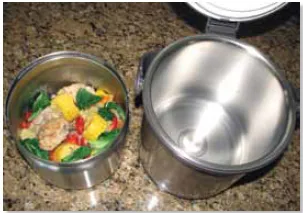
The humble vacuum flask, or thermos, is one of those 19th-century technologies that has withstood the tests of time. Originally a delicate, double-walled, glass vessel, the vacuum flask was given a new lease on life in 1978, when Thermos introduced a stainless-steel version. The ultimate domestic iteration of this, however, is the thermal cooker.
Unlike pressure cookers (PS, December 2010), which use heat and pressure to cook foods quickly, or slow-cooking Crockpots, which require a constant heat source, thermal cookers rely on thermal mass, retained heat, and insulation to maintain temperature and cook the contents. Basically, the thermal cooker is a large, stainless vacuum flask containing one or two fitted saucepans. The contents of the stainless saucepan are brought to boiling point on the stove, and then the pan is immediately placed in the vacuum flask (insulated base). The insulation traps the heat in the food and uses it as the heat source for cooking the contents. Hours later, once the contents are fully cooked, the dish requires only minimal re-heating before serving.
The main advantages of cooking with a thermal cooker are the cooking-fuel (or power) savings and the convenience of being able to safely cook a meal while underway-without constant stove-tending or worry over spilled pots-even in foul weather, when slaving over a galley stove can prove challenging and dangerous. Single-handers will particularly appreciate the ability to prep a meal before raising the anchor, leaving it to cook while sailing, and then enjoying it later-whether thats once the anchor is dropped or when the night watch begins.
The shorter stovetop-cooking time also means the cabin isn’t turned into a sauna, a plus for those in temperate and tropical climates, and there is less danger of burned food getting stuck on the pans-a common problem with some pressure cookers-making dish-washing easier.
Thermal cookers come in a range of sizes, from single-serving size (1.5 liters) to family sizes (4.5, 6, and 8 liters). They also are available with locking lids, making them a safer choice for cooking underway than standard nesting cookware (PS, April 2009). While they may be a bit bulkier than some pressure cookers weve tested, their low-profile handles make them easier to store.
Thermal cookers are ideal for cooking stews, casseroles, soups, desserts, and other dishes. Youll find some good recipes on www.thethermalcook.com.
Thermos (Shuttle Chef), Tiger (Magic Thermal Cooker), and Zojirushi are the most widely available thermal cookers in the U.S. Sizes and designs vary only slightly among the brands, and all offer options for two smaller cooking pans (instead of one large) and a steamer basket, all of which neatly nest in the base.

Our Experience
PS contributor Jonathan Neeves-a bluewater cruiser currently living aboard his Lightwave 38 catamaran in Australia-has used Thermos-brand thermal cookers for 30 years, and he maintains that he would never sail without one.
Neeves noted that the Thermos Shuttle Chef has excellent heat retention and lives up to its makers claims, keeping food hot (up to 160 degrees) for up to eight hours. He recommends using an 8-liter model for family meals on shore, a stowable 4.5-liter model with a locking lid for on-board cooking, and a single-serve model for on-watch meals and side dishes. While some boats have gimballed fittings for the cookers, Neeves uses his in the galley sink, which has proven to be a safe place for cooking underway and for ladling out food without a mess.
The Shuttle Chefs low fuel usage makes it economic, eco-friendly, and ideal for passagemaking or cruising. It comes with a one-year warranty, but its quality stainless components are well made and built to last, even in the marine environment. There are alternatives that use polystyrene instead of vacuum insulation, but they are much less efficient.
Prices for double-walled, stainless cookers run about $150 for a 4.5-liter model to $250 for an 8-liter-not cheap, but worth it for the convenience, safety, and fuel savings. You can find the Shuttle Chef at such online retailers as Amazon.com, Galtak Houseware (www.galtak.com), and Forum Appliances (www.forumappliances.com).







































